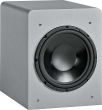Altec Lansing Model 115 Bookshelf speakers
Altec lansing's Model 115 is a two-way acoustic-suspension bookshelf speaker. Seventeen inches high and weighing only 18 pounds, it is attractively finished on all surfaces in an oak woodgrain vinyl veneer, with almost all of the front panel normally covered by the snap-on black grille. It is identical to the more expensive Model 105 except for its cabinet finish (the Model 105 uses wood veneer).
The Model 115's woofer operates in a sealed enclosure. Its 6-inch cone features the textured, woven-carbon-fiber construction used in most of the company's other home speakers, including higher-price models. The crossover, at about 2,500 Hz, is to a 1-inch titanium-coated polyamide dome tweeter with ferrofluid cooling. As with the woofer, the tweeter's design is widely used in the Altec Lansing line.
The speaker's specifications include a usable bandwidth of 40 to 22,000 Hz, with the - 3-dB points occurring at 50 and 20,000 Hz. Its power handling is specified as 50 watts nominal, 100 watts maximum, and it is recommended for use with amplifiers rated as low as 10 watts nominal output up to a maximum of 300 watts peak output. Sensitivity, with a 1-watt input, is rated as 91 dB sound-pressure level (SPL) at 1 meter, and the impedance rating is 8 ohms.
We placed the Altec Lansing Model 115 speakers on stands, about 26 inches high, for our room-response measurements. The averaged response, measured on the axis of the left speaker, was within 5 dB overall from 800 to 11,000 Hz. There was a slight high-frequency rise, to about 5 dB above the average midrange level at 15,000 Hz, and a return to the reference level at 20,000 Hz.
Below 800 Hz, room-boundary reflections affected the response, although it showed only a 7-dB overall variation down to 120 Hz. The close-miked woofer response was a maximum between 100 and 200 Hz, falling at 12 dB per octave below 100 Hz and more gradually at higher frequencies.
The composite frequency response varied only 5 dB overall from 65 to 11.000 Hz, and the high-frequency rise previously mentioned added only about 2.5 dB to that variation. The shape of the curve was a little sway-backed, with the range from 500 to 3.000 Hz slightly depressed relative to the bass and treble octaves.
Our quasi-anechoic response measurements (valid above a few hundred hertz) agreed approximately with the room-response measurements. The output rose about 4 or 5 dB from 2,500 Hz to 4,000 Hz and remained within a decibel or two of that level up to 15,000 Hz, where there was an additional 2-dB peak.
The tweeter's horizontal dispersion was good up to about 6,000 Hz (where the response 45 degrees off-axis had dropped less than 3 dB relative to the on-axis response), but the spread increased rapidly at higher frequencies, to 7 dB at 10,000 Hz and 13 dB at 20.000 Hz.
The system's impedance curve was good, with a minimum of 6 ohms at 200 Hz and maximum readings of 30 ohms at the 70-Hz bass resonance and about 20 ohms in the 1,000- to 3,000-Hz range. The impedance was safely above 8 ohms over most of the audio range.
Sensitivity measured a very good 92 dB, slightly better than rated. With an input of 2.26 volts (corresponding to a 90-dB SPL), woofer distortion was between 0.3 and 0.5 percent from 150 to 1,000 Hz. It rose slightly at higher frequencies, to about 0.8 percent at 2,000 Hz. At low frequencies the distortion rose linearly from 1 percent at 100 Hz to 4 percent at 50 Hz and 9 percent at 30 Hz. The 6-inch woofer handled one-cycle tone bursts of 180 watts at 100 Hz into its 10-ohm impedance before it began to sound hard.
The group delay in the tweeter range (2,500 to 20,000 Hz) varied less than 100 microseconds overall. There was a jump of 200 microseconds at 2,000 Hz and a second peak of about 600 microseconds at a much lower frequency, in the woofer range. These low group-delay variations indicate very good phase linearity.
The Altec Lansing 115 sounded clean, balanced, and musical, as would be expected from its measured performance and its kinship to some of the company's much more expensive speakers. Although it is too small to do full justice to the really low bass, it never sounded thin or lacking in those frequencies. The highs were crisp, probably as a result of the slight peak well above the normal musical frequency range, but they were never shrill.
One of the best demonstrations of the Model 115's capabilities was when we teamed the test pair with a couple of Hsu Research subwoofers, whose output is principally below 50 Hz, and played organ recordings that extended to about 20 Hz. The change in sound when we cut off the drive to the subwoofers was unmistakable, but also unmistakable was the manner in which the diminutive Model 115 speakers managed to convey a sense of real bass in their output, without obvious distortion or any of the thinness often associated with small speaker systems. They didn't shake the room or rattle the windows, but they always sounded musical and believable. All in all, the Altec Lansing 115 is a first-rate small speaker system at a very reasonable price.




